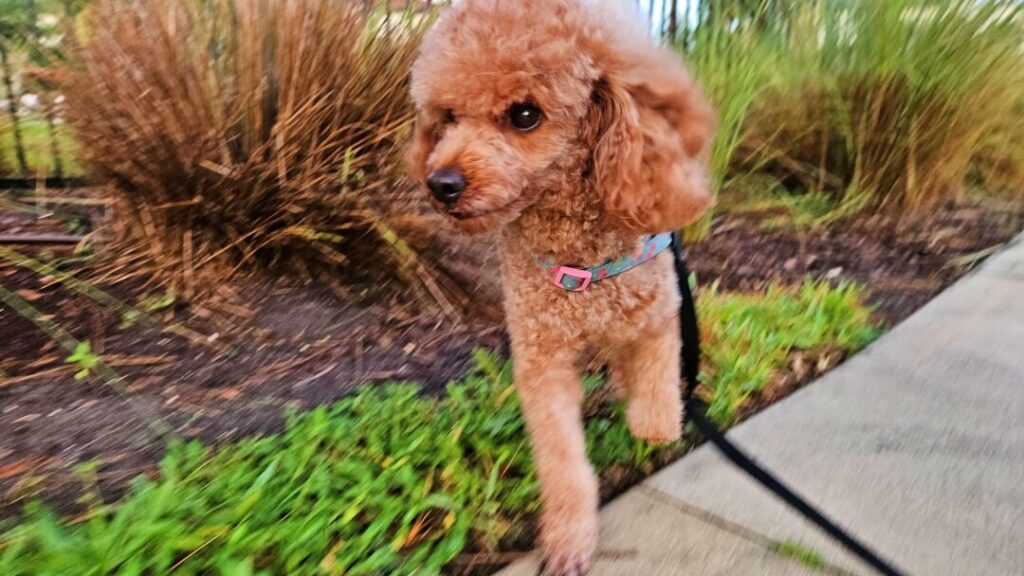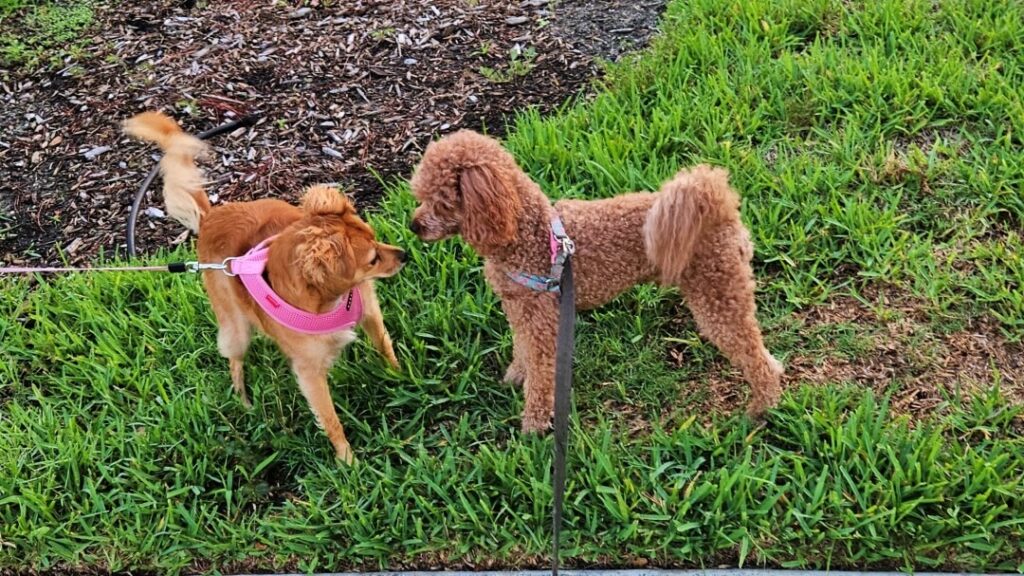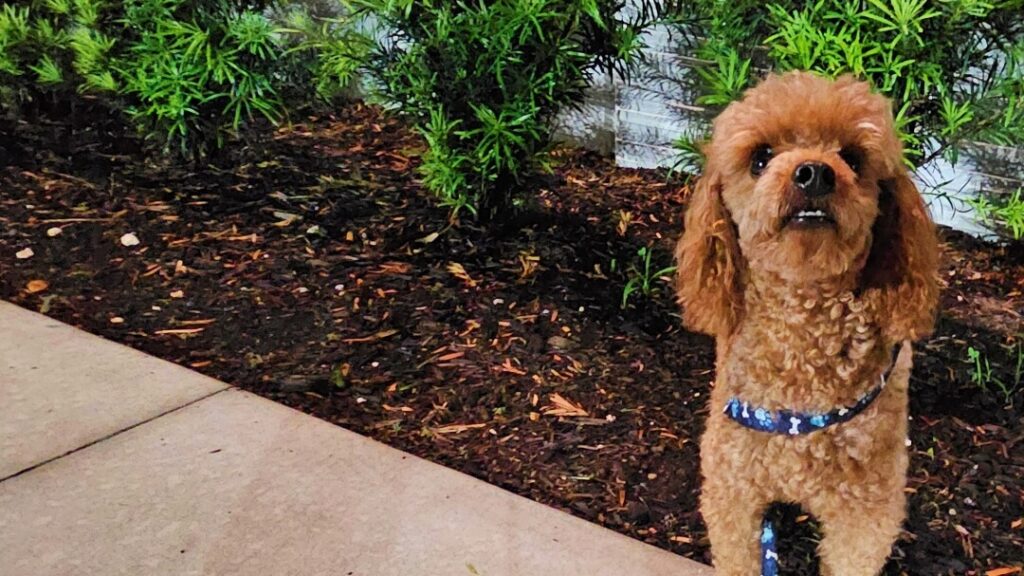Training Tips
- Basic Commands: How to teach your mini poodle basic commands.
- Advanced Tricks: Fun and advanced tricks to challenge your poodle.
- Behavioral Guidance: Tips for managing and correcting unwanted behaviors.
Making Training Fun for Your Mini Poodle
Poodles are known for their intelligence and agility, making them one of the most trainable dog breeds. This unique combination of smarts and athleticism is a double-edged sword; while it makes training easier, it also means your poodle needs regular mental and physical stimulation. In this blog post, we’ll explore essential training tips for your mini poodle, from basic commands to advanced tricks and behavioral guidance. Whether you’re a new poodle parent or a seasoned dog owner, these tips will help you build a strong bond with your furry friend and ensure they remain well-behaved and happy.

The Intelligence and Agility of Poodles
Poodles are often regarded as one of the smartest dog breeds. Their high intelligence means they can quickly pick up new commands and tricks. However, it also means they can get bored easily. This makes training crucial not just for obedience but also for mental stimulation and bonding.
Why Training is Essential
Training provides the necessary mental engagement that prevents boredom. An intelligent breed like the poodle needs tasks to keep their mind sharp. Training sessions can serve as a perfect opportunity for this.
Building a Strong Bond
Regular training sessions are not just about teaching commands but are also about building a relationship. When you train your poodle, you learn to understand each other better, creating a stronger bond between you and your pet.
Mental and Physical Exercise
Poodles are not just brainy; they are also agile. Training that incorporates physical activities helps in channeling their energy positively. This keeps them healthy and prevents behavioral issues.

Basic Commands
Teaching basic commands is the foundation of any dog training regimen. These commands are essential for safety and good behavior. Let’s break down some of the most important ones.
Sit
The “sit” command is often the first command that dog owners teach. It’s simple yet effective for controlling your poodle in various situations.
- Method
Hold a treat close to your poodle’s nose. Move your hand up, allowing their head to follow the treat and causing their bottom to lower. Once they’re in a sitting position, say “sit,” give them the treat, and share affection.
- Repetition
Repeat this process a few times every day. Consistency is key to mastering this command.
- Challenges
Once your poodle has mastered sitting, challenge them by practicing in different environments and gradually introducing distractions.
Stay
The “stay” command is useful for ensuring your dog’s safety, especially in busy environments.
- Method
Start with your poodle in a sitting position. Open your palm in front of you and say “stay.” Take a few steps back. If they stay, reward them with a treat and affection.
- Gradual Increase
Increase the distance gradually. Move slowly to ensure your poodle understands what is expected.
- Distractions
Introduce distractions once your poodle is adept at staying in place. This will help in real-world scenarios where your dog needs to control impulses.

Come
The “come” command is crucial for recall, especially in off-leash situations.
- Method
Put a leash on your poodle and say “come” while gently pulling the leash toward you. When your poodle comes to you, reward them with a treat and affection.
- Positive Reinforcement
Always use positive reinforcement. Never use the “come” command for punishment, as it should always be associated with positive experiences.
- Practice
Practice this command in various environments to ensure your poodle responds well, even with distractions.
Advanced Tricks
Once your poodle has mastered basic commands, it’s time to challenge them with more complex tricks. These tricks not only entertain but also stimulate your poodle mentally.
Roll Over
“Roll over” is a fun trick that showcases your poodle’s agility.
- Starting Position
Start with your poodle in a lying-down position. Hold a treat near their nose.
- Guiding Movement
Move your hand in a circular motion towards their shoulder. This should encourage your poodle to roll over.
- Command and Reward
Say “roll over” as they complete the action. Reward them with a treat and praise.
Play Dead
“Play dead” is an impressive trick that requires a bit more patience and persistence.
- Initial Command
Start with your poodle in a lying-down position. Hold a treat and move your hand to the side, encouraging them to lie on their side.
- Adding the Command
Once they are on their side, say “play dead” and reward them.
- Consistency
Practice this trick regularly, and soon your poodle will associate the command with the action.

High Five
This trick is a crowd-pleaser and relatively easy to teach.
- Preparation
Start by holding a treat in your hand and showing it to your poodle.
- Encouraging the Action
Raise your hand slightly above their head and say “high five.” Most dogs will naturally lift their paw to reach the treat.
- Command and Reward
When they lift their paw, say “high five” and reward them.
Behavioral Guidance
While teaching commands and tricks is important, addressing behavioral issues is equally crucial. Common problems like excessive barking and separation anxiety can be managed with the right approach.
Managing Barking
Excessive barking can be frustrating, but it’s often a sign of underlying issues.
- Identifying Triggers
Identify what triggers your poodle’s barking. Is it boredom, anxiety, or external stimuli?
- Training Techniques
Use commands like “quiet” or “enough” to manage barking. Reward your poodle when they stop barking on command.
- Distraction and Engagement
Provide distractions like toys or puzzles to keep your poodle engaged and reduce boredom-induced barking.

Handling Separation Anxiety
Separation anxiety is common in poodles and can lead to destructive behavior.
- Gradual Desensitization
Leave your poodle alone for short periods and gradually increase the duration. This helps them get used to being alone.
- Comfort Items
Provide comfort items like their favorite toy or a piece of your clothing.
- Positive Reinforcement
Reward calm behavior with treats and praise when you return home.
Correcting Unwanted Behaviors
Unwanted behaviors like chewing and digging can be managed with positive reinforcement and redirection.
- Providing Alternatives
Offer appropriate alternatives like chew toys or designated digging areas.
- Consistency
Be consistent with your commands and rewards. This helps your poodle understand what is acceptable.
- Exercise and Stimulation
Ensure your poodle gets enough physical and mental exercise to reduce unwanted behaviors.

Conclusion
Training your mini poodle is a rewarding experience that strengthens your bond and ensures a happy, well-behaved pet. From mastering basic commands to learning advanced tricks and managing behavioral issues, training offers lifelong benefits for both you and your poodle. Remember, consistency and positive reinforcement are key. Happy training!
—
By following these guidelines, you can create a well-rounded, engaging, and informative blog post that meets the needs of your target audience while adhering to the specified requirements.









